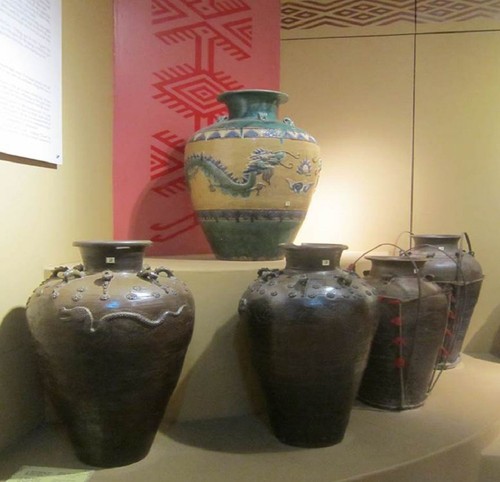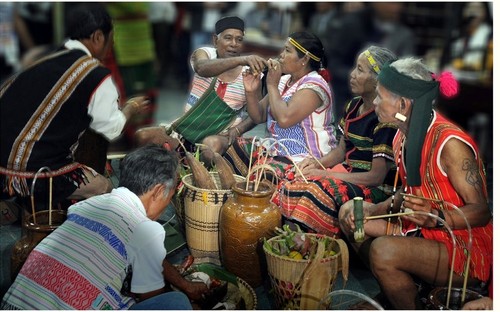 Jars (Che) displayed at the Kon Tum Museum. (Photo: baodaklak.vn) Jars (Che) displayed at the Kon Tum Museum. (Photo: baodaklak.vn) |
Ethnic groups in the Central Highlands, such as the M’nong, Ede, and Ma, call jars by different names depending on the colors, shapes, patterns, and animal images decorating them. Precious jars are sometimes named after the owner or a family name, or a related event. Jars often have a round mouth, a large bulging body, with a tapered bottom. They are made from clay, fired at high temperature, and enameled or kept rustic.
Ethnic groups in the Central Highlands consider jars their most valuable asset, the more jars they have, the wealthier they are. Some families have hundreds of jars.
“In the past jars and especially jars of liquor were extremely valuable. People cherished and preserved them very carefully. The jars were placed in the corner of the house and carefully tied down with string,” said Dr. Bui Ngoc Quang, Deputy Director of the Vietnam Museum of Ethnology.
Most of the jars are not produced by local people, but brought from other ethnic groups in other localities. As a result, the jars have diverse designs, decorations, and origins. Many of them are costly and rare.
Jars often have brown or dark yellow enamel with a simple decoration or are just left plain from daily use. Worship jars have the images of a legendary water monster, cranes, birds, trees, and leaves on the body or a tiger amulet on the jar’s handles.
Dinh Ply, Head of the Ba Na Group at the Vietnam National Village for Ethnic Culture and Tourism, said that to make a jar, the artisan had to choose the clay, set up a kiln, and hold a ceremony to inform the deities of their work.
“In the past, people made jars by themselves. Different types of clay were used to make different types of jars. Depending on family conditions, they made large or small jars. Today people do not make jars but buy them,” Dinh Ply said.
 A jar of liquor is indispensable in rituals of the Mnong in the Central Highlands. (Photo: baodantoc.vn) A jar of liquor is indispensable in rituals of the Mnong in the Central Highlands. (Photo: baodantoc.vn) |
Among jars of various shapes and sizes, the most unique type is “mother holding children”, which is often brown and unglazed.
“It’s a jar with many smaller jars on the top. It looks like a mother carrying her children,” said Dr. Quang.
The “mother holding children” jars are tall and slim. The mother jar carries one to four baby jars which are connected to each other and have the same decorations.
“The ‘mother holding children’ jar is a symbol of family happiness. They never use it but keep it in the rice field or in the forest, in a place only the mother knows,” he added.
The jars are precious assets of ethnic groups in the Central Highlands. They are restored and handed down from generation to generation. Every year, the family holds a ceremony to worship their jars. They prepare an offering of liquor, meat, and steamed rice in bamboo tubes and read the prayers of peace and happiness for the family and community while pouring liquor on the jars.